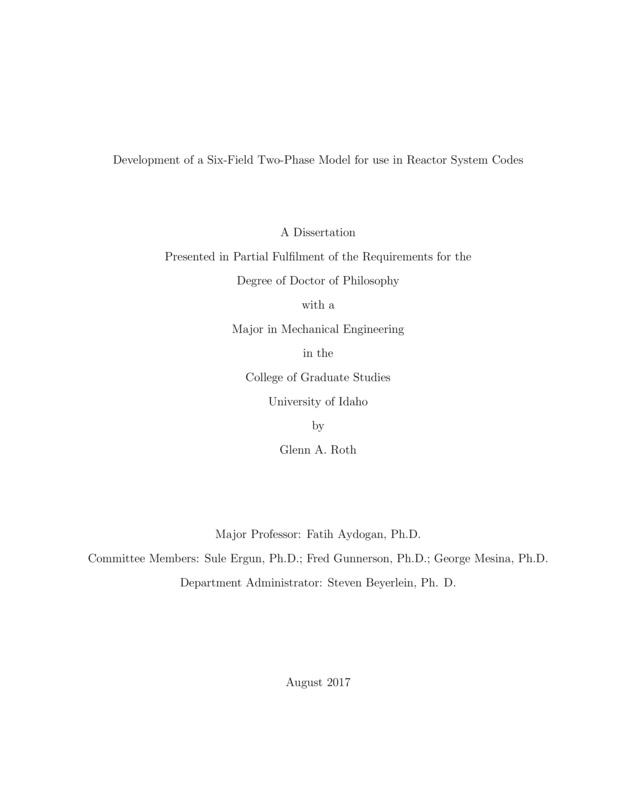Development of a Six-Field Two-Phase Model for use in Reactor System Codes
Roth, Glenn. (2017-08). Development of a Six-Field Two-Phase Model for use in Reactor System Codes. Theses and Dissertations Collection, University of Idaho Library Digital Collections. https://www.lib.uidaho.edu/digital/etd/items/roth_idaho_0089e_11213.html
- Title:
- Development of a Six-Field Two-Phase Model for use in Reactor System Codes
- Author:
- Roth, Glenn
- Date:
- 2017-08
- Keywords:
- multi-field system code two-phase flow
- Program:
- Mechanical Engineering
- Subject Category:
- Engineering; Mechanical engineering
- Abstract:
-
The design and analysis of the thermal/hydraulic systems of nuclear power plants necessitates system codes that can be used in the analysis of steady-state and transient conditions. Due to the dispersed development of system codes over many laboratories and universities, there are several system codes available for use. Many of the available codes have multiple similar versions developed for specific user needs.
System codes are used to analyze nuclear reactor systems during steady state and transient operations. These codes can predict pressure drop, void fraction distributions and temperature distributions for various coolants, heated flow geometries, and heat configurations. They also include models for various two-phase flow regimes, but extreme flow conditions that involve significant phase change can tax the current code capabilities.
Current system codes have mass, momentum, and energy conservation equations for two fields (liquid and vapor), resulting in a model with six conservation equations. Recent developments in limited applications of a few of these codes have added a separate droplet field from the continuous liquid. This is part of a trend toward the inclusion of more fields (and requisite conservation equations) in system codes.
Two-phase flows are divided into flow regimes based on their appearance and the flow structure. The regimes are used to select appropriate closure relationships to model heat transfer, interfacial drag, and other flow conditions.
The representation of two-phase flow phenomena is improved by increasing the number of fields. Conservation equations based on six fields (liquid, vapor, small bubble, large bubble, small droplet and large droplet) have been derived as part of this dissertation.
The conservation equations for mass, momentum, and energy increase the amount of information that is needed to model the flow field. This dissertation shows how several new variables are added to the system of conservation equations. These variables include source terms for physical interactions between the droplets and the vapor, droplet entrainment and break-up. In addition, heat transfer across the many interfaces must be described or the governing equations cannot be solved. Closure models that can be used to solve the expanded system of conservation equations have been identified in this work.
The solution of a system of governing equations for six fields is complex. There are 18 equations that must be solved - six field equations each for the mass, momentum, and energy conservation. This dissertation describes how the primary variables are selected, and how the 18 equations are solved in a two-step process - first the momentum equations, then the remaining 12 mass and energy conservation equations.
This dissertation is a compilation of papers that have been published or submitted for publication by the author.
- Description:
- doctoral, Ph.D., Mechanical Engineering -- University of Idaho - College of Graduate Studies, 2017-08
- Major Professor:
- Aydogan, Fatih
- Committee:
- Ergun, Sule; Gunnerson, Fred; Mesina, George
- Defense Date:
- 2017-08
- Identifier:
- Roth_idaho_0089E_11213
- Type:
- Text
- Format Original:
- Format:
- application/pdf
- Rights:
- In Copyright - Educational Use Permitted. For more information, please contact University of Idaho Library Special Collections and Archives Department at libspec@uidaho.edu.
- Standardized Rights:
- http://rightsstatements.org/vocab/InC-EDU/1.0/

